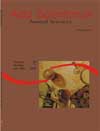Ensiling potential and chemical composition of corn plants having different proportions of ears
Abstract
This experiment was conducted at the Experimental Farm of the College of Veterinary Medicine and Animal Science - Unesp - Botucatu campus (SP), with the objective of evaluating the ensiling potential and chemical composition of corn plants submitted to different levels of ear removal at the milky stage, as well as measuring the quality of the silages obtained. A completely randomized design was used, with five treatments and three replicates. The treatments consisted of ensiling corn plants with or without saleable ears (SE), as follows: T1 - 100% SE; T2 - 75%; T3 - 50%; T4 - 25%; and T5 - without SE. The SE were harvested between 19 and 23 days after pollination (milky stage), and dry matter content and yield of different plant parts were measured. Harvest for ensiling occurred at the dough stage, at which time ensiling potential and chemical composition were determined. Silage quality was evaluated thereafter. SE removal did not affect (p>.05) either dry matter content at the milky stage or chemical composition at the dough stage. However, it changed (p<.05) TDN and soluble carbohydrate content, without jeopardizing (p>.05) silage conservation. Dry matter content is the main limiting factor for ensiling corn after SE removal and it is possible to remove up to 25% SE at the milky stage, without lowering the nutritive value of plants to be ensiled at the dough stage.Downloads
Download data is not yet available.
Published
2008-05-13
How to Cite
Costa, C., Creste, C. R., Arrigoni, M. D. B., Silveira, A. C., Rosa, G. J. de M., & Bicudo, S. J. (2008). Ensiling potential and chemical composition of corn plants having different proportions of ears. Acta Scientiarum. Animal Sciences, 22, 835-841. https://doi.org/10.4025/actascianimsci.v22i0.3231
Issue
Section
Animal Science
DECLARATION OF ORIGINALITY AND COPYRIGHTS
- I Declare that current article is original and has not been submitted for publication, in part or in whole, to any other national or international journal.
The copyrights belong exclusively to the authors. Published content is licensed under Creative Commons Attribution 4.0 (CC BY 4.0) guidelines, which allows sharing (copy and distribution of the material in any medium or format) and adaptation (remix, transform, and build upon the material) for any purpose, even commercially, under the terms of attribution.
Read this link for further information on how to use CC BY 4.0 properly.
0.9
2019CiteScore
29th percentile
Powered by 








































